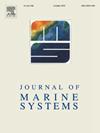Phytoplankton size structure in a subtropical area from ocean colour and its applications
IF 2.5
3区 地球科学
Q2 GEOSCIENCES, MULTIDISCIPLINARY
引用次数: 0
Abstract
Ocean colour remote sensing provides information on phytoplankton biomass at the global scale, indexed as chlorophyll-a concentration (Chl-a). Several models have also been developed to estimate phytoplankton size classes (PSCs) from ocean colour data. Here we evaluate an abundance-based (AB) model that relies on the total Chl-a as input and the spectral-based (SB) model that relies on the spectrally-resolved phytoplankton absorption coefficient (). The models were regionally adjusted using in situ data from a coastal time-series station in the South Brazil Bight, Southwestern Atlantic Ocean (ANTARES-Ubatuba). The regionally-adjusted models were applied to MODIS/Aqua images from 2002 to 2021, using the Generalized Inherent Optical Properties model (GIOP) to estimate Chl-a and . The satellite time series was used to analyse the spatio-temporal variability of phytoplankton size classes. A correlation analysis was then performed with annual mean sea surface temperature (SST), Chl-a, and micro and nanophytoplankton size fractions (). The Multivariate El Niño-Southern Oscillation Index (MEI) was used to investigate the influence of the El Niño-Southern Oscillation (ENSO) in the study region. Both PSC models performed reasonably well when tested against an independent in-situ dataset collected in the study region, yielding a correlation coefficient 0.6 and a -value 0.01. The AB model underestimated the Chl-a associated with the micro- and nano-sized classes () by 20%, while the SB model underestimated it by 48%. The AB model underestimated by 12% and the SB by 6%. The satellite validation for the showed an underestimation of 5% by the AB model and an overestimation of 18% by the SB model. A seasonal pattern was observed, with dominating the inner shelf during the austral summer and spring, and extending to the entire shelf during the autumn and winter. The micro- and nano-sized fractions showed a significant negative correlation with SST, whereas MEI was positively correlated with Chl-a and in some areas near the shelf-break, and offshore. These results suggest a potential influence of ENSO on the phytoplankton community structure of the Southwestern Atlantic, off the Southeastern coast of Brazil. The satellite-derived PSC using both models proved to be a reliable resource for ecological and climate studies, and could contribute to the study of the impact of other climate phenomena in the region. Further studies to improve the accuracy of the PSC models are also essential, especially using hyperspectral ocean colour missions that have become available recently.
亚热带海域浮游植物的大小结构及其应用
海洋颜色遥感提供了全球尺度上浮游植物生物量的信息,以叶绿素-a浓度(Chl-a)为索引。还开发了几个模型,根据海洋颜色数据估计浮游植物的大小类别(PSCs)。本文评估了以总Chl-a为输入的基于丰度的(AB)模型和以光谱分解浮游植物吸收系数(aph)为输入的基于光谱的(SB)模型。利用西南大西洋南巴西湾(ANTARES-Ubatuba)沿海时间序列站的现场数据对模型进行了区域调整。将区域调整模型应用于2002 - 2021年MODIS/Aqua影像,采用广义固有光学特性模型(GIOP)估算Chl-a和aph。利用卫星时间序列分析了浮游植物大小类别的时空变异性。然后进行了与年平均海表温度(SST)、Chl-a和浮游植物微、纳米大小组分(Fm,n)的相关分析。采用多变量El Niño-Southern振荡指数(MEI)研究El Niño-Southern振荡(ENSO)对研究区域的影响。两种PSC模型在对研究区域收集的独立原位数据集进行测试时表现相当好,相关系数ρ>;0.6, p值<;0.01。AB模型对与微、纳米级(Cm,n)相关的Chl-a低估了20%,而SB模型低估了48%。AB模型将Fm,n低估了12%,SB低估了6%。对Fm,n的卫星验证表明,AB模型低估了5%,SB模型高估了18%。在夏季和春季,Fm,n在南部大陆架内部占主导地位,在秋季和冬季,Fm,n扩展到整个大陆架。微、纳米组分与海温呈显著负相关,而MEI与Chl-a、Fm、n在大陆架断裂附近和近海呈显著正相关。这些结果表明ENSO对巴西东南海岸西南大西洋浮游植物群落结构的潜在影响。使用这两种模式的卫星衍生PSC被证明是生态和气候研究的可靠资源,并可有助于研究该地区其他气候现象的影响。进一步研究以提高PSC模型的准确性也是必不可少的,特别是使用最近可用的高光谱海洋颜色任务。
本文章由计算机程序翻译,如有差异,请以英文原文为准。
求助全文
约1分钟内获得全文
求助全文
来源期刊

Journal of Marine Systems
地学-地球科学综合
CiteScore
6.20
自引率
3.60%
发文量
81
审稿时长
6 months
期刊介绍:
The Journal of Marine Systems provides a medium for interdisciplinary exchange between physical, chemical and biological oceanographers and marine geologists. The journal welcomes original research papers and review articles. Preference will be given to interdisciplinary approaches to marine systems.
 求助内容:
求助内容: 应助结果提醒方式:
应助结果提醒方式:


